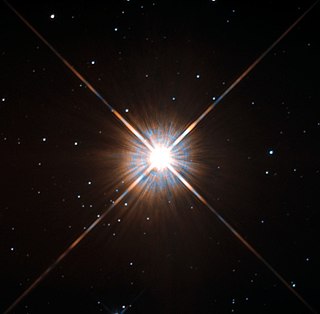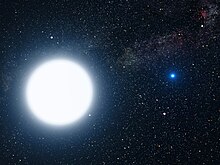
In astronomy, stellar classification is the classification of stars based on their spectral characteristics. Electromagnetic radiation from the star is analyzed by splitting it with a prism or diffraction grating into a spectrum exhibiting the rainbow of colors interspersed with spectral lines. Each line indicates a particular chemical element or molecule, with the line strength indicating the abundance of that element. The strengths of the different spectral lines vary mainly due to the temperature of the photosphere, although in some cases there are true abundance differences. The spectral class of a star is a short code primarily summarizing the ionization state, giving an objective measure of the photosphere's temperature.

A red dwarf is the smallest kind of star on the main sequence. Red dwarfs are by far the most common type of star in the Milky Way, at least in the neighborhood of the Sun. However, due to their low luminosity, individual red dwarfs cannot be easily observed. From Earth, not one star that fits the stricter definitions of a red dwarf is visible to the naked eye. Proxima Centauri, the star nearest to the Sun, is a red dwarf, as are fifty of the sixty nearest stars. According to some estimates, red dwarfs make up three-quarters of the stars in the Milky Way.

A G-type main-sequence star, also often, and imprecisely, called a yellow dwarf, or G star, is a main-sequence star of spectral type G. Such a star has about 0.9 to 1.1 solar masses and an effective temperature between about 5,300 and 6,000 K. Like other main-sequence stars, a G-type main-sequence star converts the element hydrogen to helium in its core by means of nuclear fusion, but can also fuse helium when hydrogen runs out. The Sun, the star in the center of the Solar System to which the Earth is gravitationally bound, is an example of a G-type main-sequence star. Each second, the Sun fuses approximately 600 million tons of hydrogen into helium in a process known as the proton–proton chain, converting about 4 million tons of matter to energy. Besides the Sun, other well-known examples of G-type main-sequence stars include Alpha Centauri, Tau Ceti, and 51 Pegasi.

Sigma Draconis is a single star in the northern constellation of Draco. It has the proper name Alsafi, while Sigma Draconis, which is latinised from σ Draconis and abbreviated Sig Dra or σ Dra, is the Bayer designation. It has an apparent visual magnitude of 4.7, which is bright enough to be faintly visible to the naked eye. Based on parallax measurements, this star is located at a distance of 18.8 light years from the Sun. It is receding from the Sun with a radial velocity of 26.6 km/s.

A subgiant is a star that is brighter than a normal main-sequence star of the same spectral class, but not as bright as giant stars. The term subgiant is applied both to a particular spectral luminosity class and to a stage in the evolution of a star.

A K-type main-sequence star, also referred to as a K-type dwarf, or orange dwarf, is a main-sequence (hydrogen-burning) star of spectral type K and luminosity class V. These stars are intermediate in size between red M-type main-sequence stars and yellow/white G-type main-sequence stars. They have masses between 0.6 and 0.9 times the mass of the Sun and surface temperatures between 3,900 and 5,300 K. These stars are of particular interest in the search for extraterrestrial life due to their stability and long lifespan. Well-known examples include Alpha Centauri B and Epsilon Indi.

An F-type main-sequence star is a main-sequence, hydrogen-fusing star of spectral type F and luminosity class V. These stars have from 1.0 to 1.4 times the mass of the Sun and surface temperatures between 6,000 and 7,600 K.Tables VII and VIII. This temperature range gives the F-type stars a whitish hue when observed by the atmosphere. Because a main-sequence star is referred to as a dwarf star, this class of star may also be termed a yellow-white dwarf. Notable examples include Procyon A, Gamma Virginis A and B, and KIC 8462852.

A B-type main-sequence star is a main-sequence (hydrogen-burning) star of spectral type B and luminosity class V. These stars have from 2 to 16 times the mass of the Sun and surface temperatures between 10,000 and 30,000 K. B-type stars are extremely luminous and blue. Their spectra have strong neutral helium absorption lines, which are most prominent at the B2 subclass, and moderately strong hydrogen lines. Examples include Regulus and Algol A.
HD 38529 is a binary star approximately 138 light-years away in the constellation of Orion.
109 Piscium is a yellow hued G-type main-sequence star located about 108 light-years away in the zodiac constellation of Pisces. It is near the lower limit of visibility to the naked eye with an apparent visual magnitude of 6.27. The star is moving closer to the Earth with a heliocentric radial velocity of −45.5 km/s. It has one known exoplanet.

Tau Centauri, Latinized from τ Centauri, is a solitary star in the southern constellation of Centaurus. It is visible to the naked eye with an apparent visual magnitude of +3.86. The distance to this star, based upon an annual parallax shift of 24.85 mas, is 131 light years. There is a 98% chance that it is a co-moving companion of Gamma Centauri; the two stars have an estimated separation of 1.7 ly (0.53 pc).
HD 129685 is a single star in the southern constellation of Centaurus. It is also known by its Bayer designation c2 Centauri, while HD 129685 is the star's identifier in the Henry Draper catalogue. This object has a white hue and is faintly visible to the naked eye with an apparent visual magnitude of +4.92. It is located at a distance of approximately 231 light years from the Sun based on parallax, and it has an absolute magnitude of 0.83. The star is drifting closer with a radial velocity of around −5 km/s.
HD 111968, also known by the Bayer designation n Centauri, is a single star in the southern constellation of Centaurus. It is a white-hued star that is faintly visible to the naked eye with an apparent visual magnitude of +4.25. The star is located at a distance of approximately 149 light years from the Sun based on parallax. The radial velocity of the star is poorly constrained, with an estimated value of 2.5 km/s.
HD 195019 is a binary star system in the northern constellation of Delphinus. The brighter star has a close orbiting exoplanet companion. This system is located at a distance of 122 light years from the Sun based on parallax measurements, but it is drifting closer with a radial velocity of −91.3 km/s. Although it has an absolute magnitude of 4.01, at that distance the system is considered too faint to be viewed with the naked eye, having a combined apparent visual magnitude of 6.87. However, it should be readily visible with a pair of binoculars or a small telescope.

An O-type main-sequence star is a main-sequence star of spectral type O and luminosity class V. These stars have between 15 and 90 times the mass of the Sun and surface temperatures between 30,000 and 50,000 K. They are between 40,000 and 1,000,000 times as luminous as the Sun.
HD 72659 is a star in the equatorial constellation of Hydra. With an apparent visual magnitude of 7.46, his yellow-hued star is too faint to be viewed with the naked eye. Parallax measurements provide a distance estimate of 169.4 light years from the Sun, and it has an absolute magnitude of 3.98. The star is drifting closer with a radial velocity of −18.3 km/s.
HD 126614 is a trinary star system in the equatorial constellation of Virgo. The primary member, designated component A, is host to an exoplanetary companion. With an apparent visual magnitude of 8.81, it is too faint to be seen with the naked eye. The system is located at a distance of 239 light years from the Sun based on parallax measurements, but is drifting closer with a radial velocity of −33 km/s.

HD 114613 is a fifth magnitude yellow subgiant that lies 66.7 light-years away in the constellation of Centaurus. The star may be host to a long-period giant planet.
HD 212771, also named Lionrock, is a solitary star in the southern zodiac constellation Aquarius. It has an apparent magnitude of 7.60, making it readily visible with binoculars but not the naked eye. Parallax measurements place the object at a distance of 364 light years, and is currently receding with a radial velocity of 15 km/s.

34 Leonis Minoris, also known as HD 91365 or 11 H. Leonis Minoris is a solitary star located in the northern constellation Leo Minor. It is faintly visible to the naked eye as a white-hued point of light with an apparent magnitude of 5.58. Gaia DR3 parallax measurements imply a distance of 510 light-years, and it is currently receding with a poorly constrained heliocentric radial velocity of 7 km/s. At its current distance, 34 LMi's brightness is diminished by interstellar extinction of 0.16 magnitudes and it has an absolute magnitude of −1.02.











